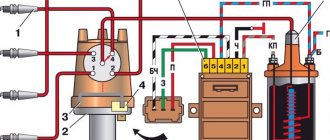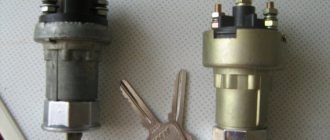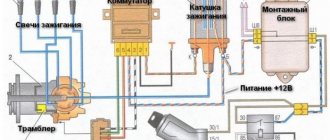From the secondary winding of the ignition coil, a high voltage is supplied to the central electrode of the distributor, which is transmitted using a slider to the side electrodes of the distributor. The speed of rotation of the slider is equal to the speed of rotation of the camshaft and relates to crankshaft revolutions in a ratio of 1:2. The side electrodes of the distributor cover are connected to the spark plugs via high-voltage wires. The main disadvantage of this system is the difficulty in ensuring timely supply of voltage to the spark plugs at different engine speeds and operating modes. This problem was partially solved by the use of a centrifugal and vacuum ignition timing regulator, and subsequently by the use of electronic units, but did not completely solve the problem. In addition, the system has many connections and wearing contacts, which significantly reduces reliability.
Typical ignition system
Ignition system components
On the technical side, the ignition system is part of the engine electrical equipment complex.
Structurally, it consists of the following elements:
- Battery or other power source. It supplies a low voltage of 12 volts to the network.
- Switch. When you turn the key, the switch closes and low voltage flows into the energy storage device.
- Energy storage. There are two types: inductive (a transformer-type ignition coil that converts low voltage into high voltage up to 30 thousand volts) and capacitive (capacitor).
- Energy storage and distribution control unit. Depending on the type of ignition system, this may be a chopper, a transistor switch, or an ECU (electronic control unit).
- Distributor. This unit can be mechanical or electronic. It supplies certain candles with energy at a given point in time.
- High voltage circuit wires. They supply high voltage to the electrodes of the spark plugs.
- Spark plug.
The operation of the ignition system is based on the following principle: when low-voltage voltage is supplied to the network, energy is accumulated and converted, which is then distributed among the spark plugs, on the electrodes of which a spark is formed, provoking the ignition of the air-fuel mixture.
Features of the contact system
Historically, the contact system was one of the first and today it can only be found on older car models. In such designs, the formation of high voltage occurs in a transformer coil, and its distribution to the spark plugs is carried out mechanically - by closing and opening the circuit contacts with a breaker-distributor.
Contact ignition system device
In addition to the main elements, such systems include a centrifugal ignition timing regulator, which is necessary to convert the ignition timing relative to the crankshaft speed. It consists of two weights acting on a mobile plate in contact with the cam mechanism of the breaker.
Ignition timing is a certain position of the crankshaft at which high voltage is supplied to the spark plugs. In this mode, ignition occurs until the piston reaches top dead center, which ensures the most efficient combustion of the air-fuel mixture.
Also in the contact circuits, a vacuum ignition timing regulator is used, which changes the timing angle according to the operating mode (load) of the engine. It is connected to the cavity located behind the throttle valve, and when you press the gas pedal, it changes the advance angle depending on the magnitude of the vacuum.
When the contacts are closed, a low voltage is applied to the primary winding of the coil, where energy is accumulated and at the moment the contact opens, a high voltage is formed on the secondary winding. The energy then goes to the ignition distributor and then to the corresponding spark plug.
If the load on the power unit increases, the rotation speed of the chopper-distributor shaft increases, and the weights of the centrifugal regulator diverge, changing the position of the plate. This promotes earlier opening of contacts, which increases the advance angle. When the load on the engine decreases, the reverse process occurs. What are the differences between a contact-transistor ignition system? The next generation of the ignition system was a contact-transistor one, which involves installing a transistor switch coil in the primary circuit. It allows you to reduce the current in the low voltage winding, which increases the service life of the contacts.
Service life and malfunctions of ignition coils
In theory, the ignition coil can be used until the car reaches 60-80 thousand kilometers. However, performance in real life depends directly on how it was used. Causes of coil malfunctions:
- Short circuit on the windings;
- Coil overheating;
- Wear due to long-term use or increased vibration;
- Charging time exceeded. Most often this happens when the car battery does not provide the required voltage level;
- Depressurization of the main components of the engine and fuel system;
- Damage to the body.
Modern cars are equipped with a warning function in case of coil failure. This is done by illuminating the Check Engine light on the dashboard.
Signs of incorrect coil operation:
- Deviation of the resistance of the transformer windings from the standard value. Diagnosed using a tester.
- Intermittent or complete failure of one or more engine cylinders, reducing engine power.
- Deterioration of internal combustion engine performance in cold (frosty) weather or high air humidity.
- Engine failure when the gas pedal is suddenly pressed.
- Poor vehicle acceleration.
It is impossible to repair the coils due to the design features. If problems are detected in their operation, they are simply replaced with new ones. Find out what condition the coils are in and replace them only at service centers. This is important, since the performance of the entire car will depend on the quality of their work.
Contact-transistor ignition system
The next generation of the ignition system was a contact-transistor one, which involved installing a transistor switch coil in the primary circuit. It allows you to reduce the current in the low voltage winding, which increases the service life of the contacts.
ignition distribution systems appeared , that is, not moving. This became possible thanks to the switching of high-voltage coils by electronic units. This system completely adjusts the moment of spark formation depending on the speed and load on the engine. There are several schemes for implementing static distribution. In the first option, there are two cylinders with ignition timing shifted by 360 degrees. the crankshaft simultaneously receives high voltage from the ignition coil. In this case, sparking occurs simultaneously in two cylinders. Since the spark plugs are connected in series to the secondary winding of the ignition coil, the spark discharge on the spark plugs will be the same discharge in the series-connected spark gaps, and will flow in the same direction. Consequently, if on one spark plug of a pair the spark discharge arc is directed from the central electrode to the side electrode, then on the other spark plug, on the contrary, from the side to the central one. At the same time, the spark energy will be different. This is due to the environment in which the spark was generated. When one spark plug is in the cylinder where the compression stroke occurs, the other is in the cylinder where the end of the exhaust stroke occurs. High pressure is applied to one of the spark plugs and it ignites the mixture; the spark on the other spark plug jumps to idle. The energy of a spark discharge that does not ignite the mixture is the same as the total loss of current in the spark gaps between the rotor and the side contacts with high-voltage ignition distribution. The picture changes to the opposite after one beat. This method uses one coil in a two-cylinder engine and two coils in a four-cylinder engine, working in pairs 1 - 4 and 2 - 3 cylinders. The coils are controlled by a two-channel switch at the command of the controller. Often the coil control key is built into the controller.
Contact-transistor ignition system
Due to the installation of a transistor, the voltage supplied to the spark plugs is 30% greater than in a classic contact system. The gap between the electrodes and, as a consequence, the length of the spark is also larger, which means that the contact area with the air-fuel mixture also increases, which contributes to its complete combustion. In a contact-transistor ignition system, the breaker acts not on the coil, but on the switch.
When you turn the key, two types of currents begin to pass through the transistor:
- management;
- main current of the primary winding.
When the contacts open, the control circuit current disappears and the transistor turns off, preventing primary current from flowing. At this moment, the magnetic field forms a high voltage on the secondary winding. To speed up the turn-off of the transistor, a pulse transformer can be installed in a contact ignition system of this type.
Operating principle of the contactless system
An evolutionary continuation of the transistor-contact system is contactless ignition. In such designs, a special pulse sensor is installed instead of a breaker. This makes it possible to increase the service life of the ignition system due to the absence of malfunctions associated with the breaker contacts.
The sensor generates low voltage electrical pulses. It comes in three types:
- Hall Sensor . The design of such a sensor includes a permanent magnet and a semiconductor wafer equipped with a microcircuit.
- Inductive . The principle of its operation is based on changing the induction value of the sensing element depending on the size of the gap between the sensor and a moving plate rotor acting on the magnetic field.
- Optical . It consists of an LED, a phototransistor and a matching chip. When light from the diode hits the phototransistor, the sensor supplies ground (minus power) to the switch. Blocking the flow of light provokes the disappearance of the current in the coil and contributes to the further formation of a spark.
Structurally, the pulse sensor is integrated into the distributor and is regulated by the engine crankshaft rotation mode. Interruption of the current in the primary winding of the ignition coil of the contactless system is also carried out by a transistor switch, but responding to sensor signals. When the crankshaft rotates, the sensor sends voltage pulses to the switch. The latter, accordingly, generates current pulses in the low voltage winding of the coil. When no current flows, a high voltage appears on the secondary winding, which is transmitted to the distributor and then through high-voltage wires to the desired spark plug. Changing the advance angle in a contactless ignition system is also performed by centrifugal and vacuum regulators.
Basic faults
The control unit constantly monitors the uniform rotation of the engine shaft. In case of ignition problems, it gives a signal about the presence of misfires in individual cylinders. In case of complete failure, the engine does not start at all or does not operate on all cylinders.
The reasons may be different:
- failure of spark plugs due to defects or untimely replacement, which not all drivers know about;
- breakdown of the insulation of the ignition coils, as a result of untimely replacement of spark plugs and an abnormal increase in their spark gap;
- burnout of power transistor switches in the control unit for various reasons, usually a manufacturing defect;
- failure of the main sensors, in modern systems this is the crankshaft position sensor, in outdated systems it is the Hall sensor in the distributor;
- in battery systems, burnt contacts and breakdown of the capacitor;
- in systems with an ignition distributor, the slider, the cover with contacts often breaks, or the interference resistor burns out;
- complete failure occurs when the contact group in the ignition switch burns out, the entire system is left without power.
Maintenance of the system comes down to the scheduled replacement of spark plugs. Conventional copper-nickel ones should be changed every 10-15 thousand kilometers, and those containing noble metals - after about 60 thousand. Otherwise, you will have to replace the ignition coils along with them, which is much more expensive.
Electronic and microprocessor systems
The most modern system is considered to be electronic. It has no mechanical contacts, and therefore can also be called contactless. Electronic ignition is part of the engine management system.
In this system there is practically no voltage loss, as in the previous ones, and the operation of each spark plug does not depend on the work of other spark plugs, as in the first and second variants of static ignition. In addition, in this case, the ignition timing is precisely adjusted directly in each cylinder, which allows complete combustion of fuel, thereby reducing the emission of harmful substances into the atmosphere.
Electronic ignition system
There are two types of electronic contactless ignition systems:
- With distributor . In such a circuit, a mechanical ignition distributor is used, which supplies high voltage to a given spark plug.
- Direct ignition . With this scheme, high voltage is supplied to the spark plug electrodes directly from the coil.
In addition to the basic elements, the electronic ignition system includes:
- Input sensors . They record data about the current operating mode of the motor and supply it in the form of electronic signals to the control unit.
- Electronic control unit . It processes the signals and transmits the appropriate commands to the igniter.
- Actuator , or igniter. In fact, it is a transistor board that, in open mode, provides voltage supply to the primary winding, and in closed mode, cuts off and generates high voltage on the secondary winding of the coil.
Such systems can be equipped with one common (in designs with a distributor), individual (when energy is supplied directly to the spark plug) or dual ignition coils.
A type of electronic system is a microprocessor. It uses a whole complex of sensors, the signals of which are processed by the ECU. It calculates the optimal operating mode of the system at a given point in time. The advantages of this design are reduced fuel consumption and improved dynamic characteristics of the vehicle.
Early or late ignition, which is better?
The required ignition timing is certainly an important factor that affects the overall performance of the car. This indicator regulates the overall performance of the car. Many people are interested in which ignition option is better: late or early. The answer is surprising, since none of the proposed options is correct.
The optimal ignition mode is considered the best for the engine.
With it, the motor will not feel high loads. Extreme late and early options will certainly bring the car owner many problems with the technical condition of the vehicle. However, everything has its own nuances, in this case they need to be considered in more detail.
Signs of early ignition
- unusual sounds from the engine that appear due to increased wear;
- increased detonation;
- insufficient power, especially noticeable at low speeds.
Signs of late ignition
- poor starting quality, which is very harmful to the battery;
- increased fuel consumption;
- loss in power;
- The engine temperature increases much higher than normal.
As you can see, both in the first case and in the second, there are few pleasant moments. Despite this, many car owners (especially domestically produced cars) choose a later ignition when warming up the engine and at the start. Some perform early ignition, but in this case the power will drop significantly at low speeds.










